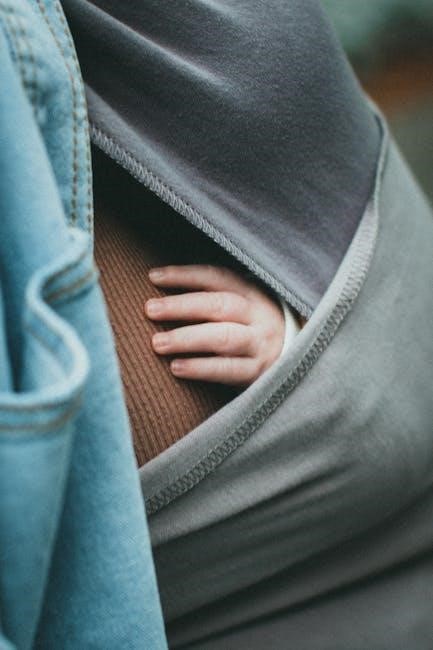baby wrap carrier instructions
A baby wrap carrier is a soft, fabric-based solution for holding your baby close, promoting bonding and ease of movement. It is a versatile, hands-free option for parents, offering comfort and support for both caregiver and child. Designed to distribute weight evenly, baby wraps are ideal for newborns and toddlers, allowing for various carrying positions. They are easy to use, breathable, and adaptable to different body types, making them a popular choice for everyday activities. With proper instructions, a baby wrap ensures a safe and snug environment for your little one, fostering a sense of security and closeness.
Safety Instructions for Using a Baby Wrap
Ensuring your baby’s safety while using a wrap is paramount. Always check the fabric for any signs of wear or damage before use. Avoid loose clothing that could interfere with the wrap’s fit, and keep the wrap snug to prevent your baby from slumping. Be mindful of your surroundings, especially near doorframes, windowsills, or other potential hazards. Regularly inspect the wrap for frayed edges or weakened seams, as these could compromise safety. When tying the wrap, make sure it is tight enough to support your baby securely, with their bottom at knee level and their airway unobstructed. Practice tying the wrap in front of a mirror or with assistance to ensure proper positioning. Lastly, never leave your baby unattended while they are in the wrap, and avoid activities that could cause imbalance, such as bending over sharply. By following these guidelines, you can create a safe and comfortable environment for your baby.
Different Carrying Positions
Baby wrap carriers offer flexibility with various carrying positions, including front, back, and hip carries. Each position ensures comfort and support for both baby and caregiver, adapting to different needs and preferences.
3.1. Front Carry
The front carry position is ideal for newborns and young infants, allowing face-to-face interaction and easy monitoring; Place the baby in the center of the wrap, ensuring their legs are spread knee-to-knee. The fabric should support the baby’s back, keeping them upright. This position is perfect for breastfeeding and provides a sense of closeness. Ensure the wrap is snug to avoid slumping, and keep the baby’s airway clear. For older babies, the front carry can be adjusted to an outward-facing position, offering a view of the surroundings while maintaining comfort and support. This versatile position is a favorite among parents for its practicality and emotional benefits, fostering a secure and loving environment for the baby.
3.2. Back Carry
The back carry position is perfect for older babies and toddlers who enjoy exploring their surroundings. To achieve this, place the baby on your back, ensuring their legs are spread knee-to-knee and their weight is evenly distributed. The wrap should be secured snugly around your torso, with the baby’s back supported and their head visible above your shoulder. This position allows for greater freedom of movement and is ideal for outdoor activities or tasks that require both hands. When tying the wrap, ensure the fabric is spread wide across your back for optimal comfort and support. The back carry promotes healthy hip development and provides a sense of security for the baby. It’s a great option for longer periods of carrying, as it distributes the baby’s weight more evenly. Always practice the back carry in front of a mirror or with assistance until you feel confident in the technique.

3.3. Hip Carry
The hip carry is a convenient and comfortable position, ideal for older babies who enjoy sitting up and observing their environment; To achieve this, the baby is placed on one hip, with their legs straddling your side. The wrap is wrapped around your torso, securing the baby in place, and the fabric is spread evenly across your hip for support. This position allows for easy access to the baby while keeping your hands free. The hip carry is great for quick errands or when you need to switch between carrying and other activities. It promotes good posture for the baby and can help with weight distribution, reducing strain on your back. When tying the wrap for a hip carry, ensure the fabric is snug but not too tight, and the baby’s position is secure. Practice this position with a mirror or assistance to ensure comfort and safety for both you and your baby;

Step-by-Step Tying Instructions
To tie a baby wrap, start by unfolding and centering it. Bring the ends over your shoulders and tuck them under the fabric to secure your baby. Adjust for comfort and support.
4.1. Front Tying Instructions
For a front tie, start by unfolding the wrap and finding the center. Place the baby in the center, ensuring the fabric is spread evenly across their back. Guide the baby’s legs into the vertical pieces, making sure the fabric covers their back and bottom for proper support. Bring one end of the wrap over your shoulder and tuck it under the opposite side, then repeat with the other end. Cross the ends behind your back and bring them forward, tying them securely under the baby. Adjust the tension by pulling the edges of the wrap to ensure a snug fit. Finally, check that the baby is in a safe position, with their head visible and close to your chest. Regularly monitor the baby’s comfort and adjust the wrap as needed for optimal support and safety.
4.2. Back Tying Instructions
To tie a baby wrap on your back, start by placing the baby in the center of the unfolded wrap, ensuring the fabric is evenly spread across their back. Guide the baby’s legs into the vertical pieces of fabric, making sure the wrap covers their back and bottom for proper support. Bring one end of the wrap over your shoulder and tuck it under the opposite side, then repeat with the other end. Cross the ends behind your back and bring them forward, tying them securely at your waist. Adjust the tension by pulling the edges of the wrap to ensure a snug fit. Make sure the baby is in a safe position, with their head visible and close to your chest. Regularly monitor the baby’s comfort and adjust the wrap as needed for optimal support and safety. This method allows for a secure and comfortable back carry, ideal for older babies and toddlers.

Ensuring Safety and Comfort
Always perform safety checks before and during use to ensure the baby’s well-being. Ensure the fabric is in good condition, free from tears or damage. Keep the baby visible, close, and their chin off your chest for proper breathing. Maintain a snug fit to prevent slumping and ensure the baby’s head is supported. Regularly adjust the wrap as needed to accommodate the baby’s growth and comfort. Distribute weight evenly across your body to avoid strain. Monitor the baby’s comfort and reposition if necessary. Be mindful of surroundings to prevent accidents, especially near sharp objects or hot surfaces. By following these guidelines, you can ensure a safe and comfortable experience for both you and your baby.

5.1. Checking Fabric Condition
Regularly inspect the fabric of your baby wrap carrier to ensure it remains safe and durable for your child. Check for any signs of wear, such as frayed edges, loose threads, or small holes, which could weaken the fabric over time. Ensure the material is free from stains or spills that might compromise its integrity. Pay special attention to the seams, as they bear the most weight, and verify that they are secure and evenly stitched. If you notice any damage, repair or replace the wrap immediately. Additionally, avoid using fabric softeners or harsh detergents, as they can degrade the fabric’s quality. Always follow the manufacturer’s washing instructions to maintain the wrap’s condition. A well-maintained baby wrap ensures optimal support and safety for your baby, providing peace of mind for both you and your child.
